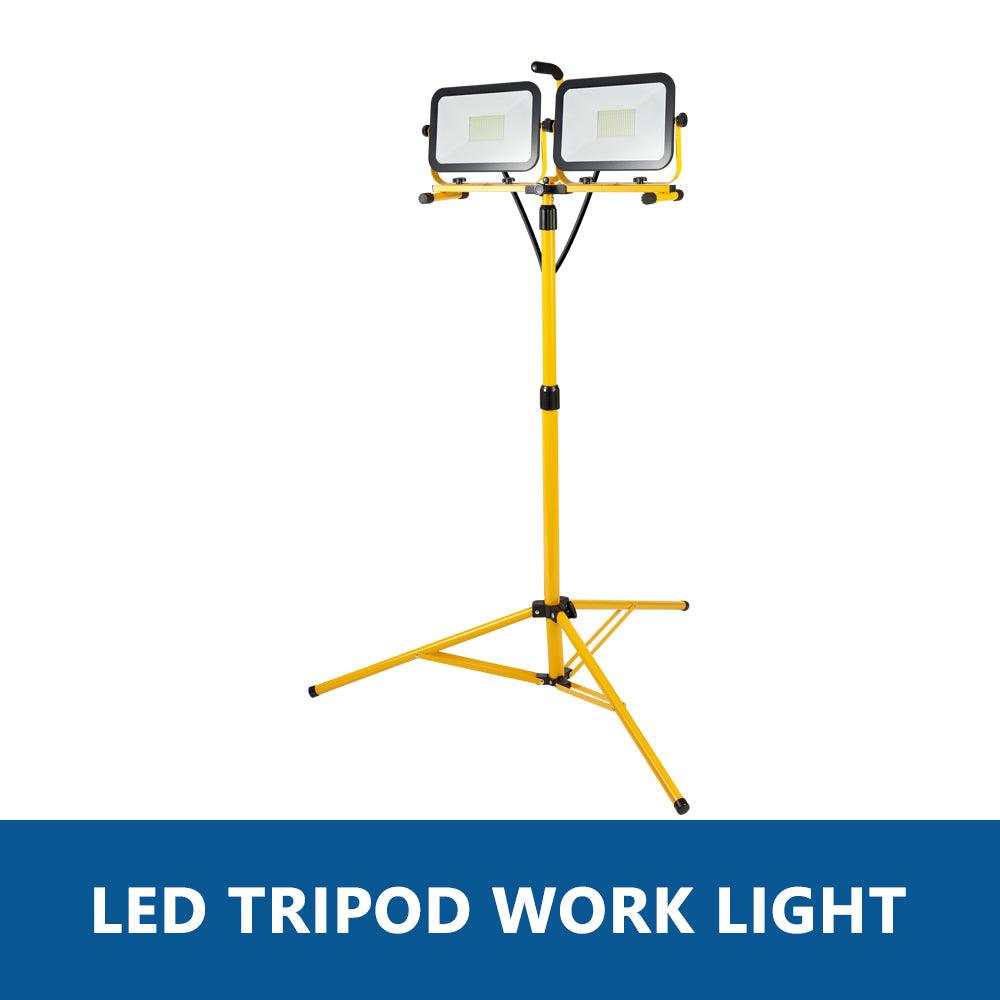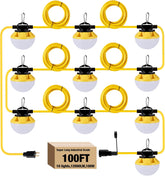-
G GJIA 100W LED Construction String Light Round Series 100FT 12,000LM 2 Prong
- from $76.99
$108.99- from $76.99
- Unit price
- per
-
G GJIA 100W LED Construction String Light Round Series 100FT 12,000LM 3 Prong
- from $96.99
$119.99- from $96.99
- Unit price
- per
-
G GJIA LED Construction Temporary Job Site Hanging Linkable Work Light
- from $67.99
$69.99- from $67.99
- Unit price
- per
-
G GJIA LED Loading Dock Lighting Square Series, Single Bracket
- from $139.99
$179.99- from $139.99
- Unit price
- per
-
G GJIA 60W 6,600LM LED Loading Dock Lighting Round Series, Single Bracket
- $149.99
$180.00- $149.99
- Unit price
- per
-
G GJIA 200W LED Tripod Light 25,000LM, 2 Head Portable Work Lights on Stand
- $89.99
$165.50- $89.99
- Unit price
- per
-
G GJIA 60W 6,600LM LED Loading Dock Lighting Round Series, Double Bracket
- from $159.99
$190.00- from $159.99
- Unit price
- per
-
G GJIA 50W LED Construction String Light Round Series 50FT 6,000LM 18AWG 2 Prong
- from $46.99
$62.00- from $46.99
- Unit price
- per
-
G GJIA 80W LED Tripod Light 10000LM, 2 Head Portable Work Lights on stand
- $72.99
$112.00- $72.99
- Unit price
- per
-
G GJIA LED Loading Dock Lighting Square Series, Double Bracket with Plug
- from $149.99
$189.99- from $149.99
- Unit price
- per
High Bay Lights
Popular Products
- from $48.99
$53.99- from $48.99
- Unit price
- / per
- from $44.99
$59.99- from $44.99
- Unit price
- / per
- from $164.99
$219.99- from $164.99
- Unit price
- / per

Temporary Lighting for Construction Sites and Workplaces & LED Work Lighting
Replacing a 400-watt metal halide overhead light with a 324-watt fluorescent light can save 19% of energy. If you switch from metal halide to LED work lights, energy savings increase to 65%, lifespan triples, and safety is significantly improved. LED work lights not only save money but also have a high color rendering index, which displays everything in its true color under the light, making them highly favored by construction workers and on-site renovation workers.
LED work lights are designed to be durable and portable, providing very bright light as supplemental lighting for various occasions. We offer a wide variety of LED work lights for you to choose from.
LED Dock Lights
Dock lights are specially designed for cold storage and docks because truck trailers do not have internal lighting when unloading goods. These lights are installed at the dock entrance to provide a light source. The dock lights come with retractable and rotating swing arms, allowing you to adjust the light source direction from multiple angles, making them very convenient. Nowadays, dock lights are widely used by professional carpenters, watchmakers, designers, artists, and DIY enthusiasts as workbench lighting, offering convenience and reliability.
LED String Work Lights
Construction LED string work lights are loved by customers for their plug-and-play feature and bright illumination. Each construction light comes with a hook design, allowing it to be installed anywhere it’s needed.
How to Connect LED Temporary Work Lights?
LED work lights can be used directly by plugging them in. They are equipped with a safe 3-pin plug (except for string lights) and can be interconnected after connecting to a power source. The maximum continuous distance is 500 meters, with a capacity close to 500W.
Double-Headed Work Lights with Stand
The angle of the two light heads can be adjusted, and the height of the stand is also adjustable. There are two brightness settings, with an output of up to 12,000 lumens. Perfect for detailed work and supplemental lighting.
PORTABLE AND VERSATILE HANGING CONSTRUCTION LIGHTS
Our portable hanging construction lights are designed for projects requiring flexible lighting solutions. Easily hang these lights from various structures to focus light precisely where needed, enhancing task-specific illumination. Lightweight and easy to move, these hanging lights are perfect for any construction project needing adaptable and convenient lighting.
Portable LED Work Lights
These work lights can be daisy-chained, are durable, and feature a hook design for easy carrying. LED temporary work lights are designed with 4+1 panels, allowing for wider light diffusion and 360° all-around lighting coverage. The Honeycomb series comes with a stainless steel guard for better impact protection.
Choose LED Work Lights from JC-LGL®. Call us to let us know how we can help. We guarantee durability and quality, which is why you get a five-year limited warranty.
Frequently Asked Questions About LED Work Lights
Q: Where are LED work lights typically used?
A: LED work lights are commonly used in various environments, including workshops, garages, studios, construction sites, auto repair shops, and warehouses, making them the best choice for supplemental lighting.
Q: Can LED work lights be used in outdoor settings?
A: Yes. LED work lights are designed to be robust, rainproof, bright, and energy-efficient, making them equally suitable for outdoor construction projects.
Q: How to choose the right camping power supply for led work lights?
A: When using a power bank for LED work lights during camping, ensure the output port matches the device's charging interface (e.g., USB). Check that the power bank meets the voltage and current specifications to avoid damage. Its capacity, measured in mAh or Wh, determines how long it can power the light. If multiple devices need charging, choose a power bank with several output ports for convenience.
Q: Common uses for LED work lights?
A: LED work lights serve various purposes, from construction sites and auto repair shops to home garages, warehouses, and outdoor recreational activities, providing versatile and dependable lighting.
Q: What size work light do I need?
Workspace or garage: 8,000 to 10,000 lumens. Kitchen work areas: 7,000 to 8,000 lumens. Bathroom: 7,000 to 8,000 lumens. Home office: 6,000 to 8,000 lumens.
Q: Determining the needed size for work lights?
First measure your space and multiply the length by the width to get your square feet. Then multiply your square feet by 70 to get the minimum lumen requirement for your workshop. For example, my store is 12 feet x 16 feet = 192 square feet. I need at least 192 x 70 = 13440 lumens.
Q: What is the ideal light for work?
In general, warm yellow or warm orange lights are better for relaxing and unwinding, while cool blue or cool white lights are better for waking up, working, and concentrating. Both fluorescent and LED bulbs emit light in the blue and white spectrum, making them ideal for morning illumination.
Q: Is 2000 lumens bright enough for a work light?
In automotive repair settings, where detailed work is performed, a work light with a lumen output of 2000-5000 is generally suitable. The light should have adjustable brightness settings for better control.
Q: What is the OSHA rule for lighting?
According to ANSI/IES RP-1-19, the following are some common lighting requirements:
- General office: 30 to 50 ft candle light (fc).
- Fine work area: 70 to 1000 ft candlelight, depending on how fine the work is.
- Computer work area: Candle light below 50 feet to reduce glare and eye strain.
Q: What is the best light for the workplace?
In general, warmer yellow or orange lights tend to be better for relaxing, whereas cooler blue and white lights are good for working, waking up, and concentrating. If possible, the lighting temperature and color should vary based on the time of day.
Q: How should the lighting be for a workplace?
Use a Blend of Lighting Types. Blend natural light with artificial sources. Task lighting, ambient lighting, and accent lighting need to work together. Task lighting should focus on areas where detailed work happens. Ambient lighting should spread evenly across the room, creating a base layer of light.
Q: What are the recommended lighting requirements?
Studies and home offices require good levels of lighting, with between 400 and 500 lux for task lighting on desks. If more intricate work is being undertaken, we recommend 750 lux.
Q: What is the difference between a lux and a lumen?
What is a lux? The concepts of lux and lumen are closely related. While lumens measure the amount of light emitted by a source, luxes determine the same amount of light, but are projected onto a surface. Therefore, one lux is equivalent to one lumen per square meter.
Q: How many lumens do I need for office lighting?
Typically, most offices will be strive for a maximum of 500 lumens per square meter (also known as lux) although you could scale down to a minimum of 300 lumens as recommended by IES office lighting standards.
Q: What is the sufficient lighting of working space?
In general, the more detailed the task, the greater the light requirement. A process control room should be lit at an illuminance of 300 lux, a corridor or walkway may only require 50 lux, whilst studying an engineering drawing may require 750 lux (see HSG38 Lighting at Work).
Q: What is ideal lighting height?
The general rule is 1 foot for every 3 inches, meaning that for every foot in height your room is, the chandelier should be 3 inches. For example, in a standard 8-foot ceiling height bedroom, the light should hang no lower than 24 inches.
Q: Which light is best for office work?
LED lighting is the best option for office environments as lights must be lit instantly. For office spaces, a neutral white light in the 4000K to 5000K color temperature range is ideal. It promotes alertness, supports concentration, and offers accurate color representation, making it suitable for a productive work environment.
Q: What are the OSHA measurements for lighting?
OSHA provides candle-feet breakdowns for various types of work as follows: First-aid stations, offices, and infirmaries: 30 foot-candles. General construction plants and shops: 10 foot-candles. General construction area: 5 foot-candles.
Q: How do you calculate lighting requirements?
- Measure your room's dimensions. E.g. 10-by-10 feet.
- Calculate the total sum of the lumens produced by all of your light sources. ...
- Divide your total lumen output by your room's square footage.
Q: What is the minimum lighting requirement for offices?
OSHA's general industry lighting requirements are: Offices, First Aid Stations, and Infirmaries: The minimum brightness stands at 30 foot-candles. This level of illumination promotes visibility, especially in areas where accurate color perception and visual acuity are critical.
Q: Is 5000 lux the same as 5000 lumens?
No, 5,000 lux is not the same as 5,000 lumens. 5,000 lux indicates the brightness at a specific point, while 5000 lumens represents the total light output from a source.
Q: What size should my light be?
As a general rule, the diameter of your fixture should be proportional to the room's dimensions. For rooms under 100 square feet, consider a fixture between 12 and 24 inches in diameter. Larger rooms may require fixtures measuring 24 inches or more.
- Choosing a selection results in a full page refresh.



































